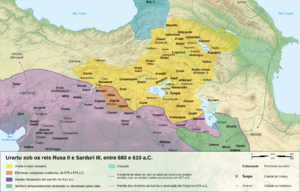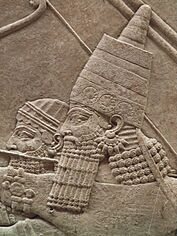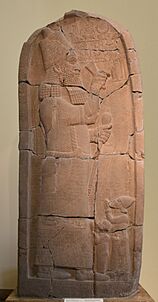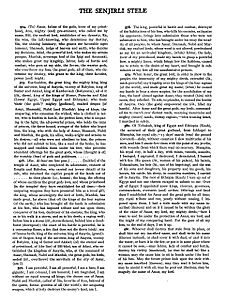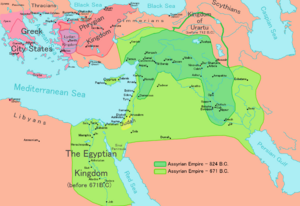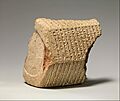Esarhaddon facts for kids
Quick facts for kids Esarhaddon |
|
|---|---|
|
|

Esarhaddon, closeup from his victory stele, now housed in the Pergamon Museum
|
|
| King of the Neo-Assyrian Empire | |
| Reign | 681–669 BC |
| Predecessor | Sennacherib |
| Successor | Ashurbanipal (King of Assyria) Šamaš-šuma-ukin (King of Babylon) |
| Born | c. 713 BC |
| Died | 1 November 669 BC (aged c. 44) Harran (now Şanlıurfa, Turkey) |
| Spouse | Ešarra-ḫammat Other wives |
| Issue Among others |
Šērūʾa-ēṭirat Ashurbanipal Šamaš-šuma-ukin |
| Akkadian | Aššur-aḫa-iddina Aššur-etel-ilani-mukinni |
| Dynasty | Sargonid dynasty |
| Father | Sennacherib |
| Mother | Naqiʾa |
Esarhaddon was a powerful king of the Neo-Assyrian Empire. He ruled from 681 BC to 669 BC. He was the third king from the Sargonid dynasty. Esarhaddon is best known for conquering Egypt in 671 BC. This made his empire the largest the world had ever seen. He also rebuilt the city of Babylon, which his father had destroyed.
Esarhaddon's journey to the throne was not easy. His older brother, Aššur-nādin-šumi, was supposed to be king. But he was captured and likely killed. Then, his second oldest brother, Arda-Mulissu, became the heir. However, in 684 BC, Esarhaddon, a younger son, was chosen instead. This made Arda-Mulissu very angry.
In 681 BC, Arda-Mulissu and another brother murdered their father, Sennacherib. They hoped to take the throne. But Esarhaddon quickly gathered an army. He defeated his brothers in a short civil war. This made him the new king of Assyria.
His brothers' betrayal deeply affected Esarhaddon. He became very cautious and didn't trust many people. This included his officials and even male family members. Because of this, many of his palaces were like strong forts. They were built outside busy city centers for safety. Interestingly, his female relatives, like his mother Naqiʾa and daughter Šērūʾa-ēṭirat, gained more power. They had more influence than women in Assyrian history before him.
Even with a short and tough reign, Esarhaddon is seen as one of the greatest Assyrian kings. He won many battles and built amazing projects. He conquered new lands and made sure his two sons, Ashurbanipal and Šamaš-šuma-ukin, took over peacefully after him. Ashurbanipal became king of the empire, and Šamaš-šuma-ukin became king of Babylon.
Becoming King

Esarhaddon was chosen as the next king of Assyria three years before his father's death. Everyone in the empire had promised to support him. But becoming king was still very difficult.
His father, King Sennacherib, first chose his oldest son, Aššur-nādin-šumi, to be his heir. This son was made ruler of Babylon around 700 BC. Later, Sennacherib attacked the land of Elam (modern-day southern Iran). The Elamites fought back. In 694 BC, they captured Ashur-nadin-shumi in the city of Sippar. The prince was taken to Elam and likely killed. Sennacherib then took harsh revenge on the Elamites and Babylonians.
After Ashur-nadin-shumi's death, Sennacherib chose his second oldest son, Arda-Mulissu, as the new heir. But in 684 BC, Esarhaddon was chosen instead. No one knows why Arda-Mulissu was suddenly removed. Esarhaddon later wrote about his brothers' anger:
I was the youngest of my older brothers. But the gods chose me. My father asked the god Shamash, "Is this my heir?" The gods answered, "He is your second self."
Then my brothers went crazy. They drew their swords in Nineveh. But the gods were angry at their evil deeds. They made them weak and put them under me.
Arda-Mulissu had to promise loyalty to Esarhaddon. But he kept asking his father to make him heir again. These requests didn't work. Sennacherib realized the situation was dangerous. So, he sent Esarhaddon away to the western provinces for his safety. Esarhaddon was not happy about this. He blamed his brothers, saying:
They spread bad rumors and lies about me. They plotted evil behind my back. They turned my father's heart against me. But secretly, he still wanted me to be king.
Sennacherib knew his sons were dangerous to Esarhaddon. But he didn't realize the danger to himself. On October 20, 681 BC, Arda-Mulissu and another brother killed their father in a temple in Nineveh. But Arda-Mulissu's dream of becoming king was crushed. The murder caused problems among his supporters. This delayed his plans. Meanwhile, Esarhaddon raised an army.
Esarhaddon's army met his brothers' army. Most of his brothers' soldiers left them and joined Esarhaddon. The enemy generals ran away. Esarhaddon then marched into Nineveh without anyone stopping him. Six weeks after his father's death, he was accepted as the new Assyrian king. He quickly punished all those who had plotted against him. His brothers, Arda-Mulissu and Nabû-šarru-uṣur, escaped to the kingdom of Urartu in the north.
Esarhaddon's Rule
Trust Issues
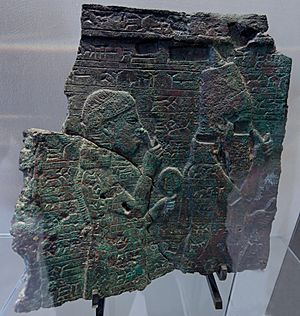
Because of the difficult way he became king, Esarhaddon didn't trust many people. He often asked priests and oracles if his relatives or officials wanted to harm him. He was especially wary of his male relatives.
However, Esarhaddon seemed to trust his female relatives. His wife Ešarra-ḫammat, his mother Naqiʾa, and his daughter Šērūʾa-ēṭirat all had a lot of power. They had more influence than women in earlier Assyrian history.
His caution also showed in where he lived. One of his main homes was a palace in Nimrud. It was built like a fort, away from the city center. Between 676 and 672 BC, this palace was made even stronger. Its entrances became like un-breakable forts. A similar palace was built in Nineveh, also far from the city center.
All Assyrian kings sought advice from the gods. But only Esarhaddon's records show him asking about possible betrayals. Some historians believe he might have developed a serious trust issue after his father's murder. Others simply call him "mistrustful." They note that he likely had many real enemies.
Rebuilding Babylon

Esarhaddon wanted the people of Babylonia to support him. So, he started many building projects there. Babylonia had only recently become part of the Assyrian Empire. His father had destroyed the city of Babylon in 689 BC. Even the statue of Marduk, Babylon's main god, was taken away.
Esarhaddon announced the rebuilding of Babylon in 680 BC. This became one of his most important projects. The work was huge. It involved clearing a lot of rubble. Many Babylonians had been enslaved or scattered. They were brought back to resettle the city. Most buildings were rebuilt. This included the great temple of Bel, called the Esagila, and the huge ziggurat called Etemenanki. The city's inner walls were also repaired.
This project showed kindness to the Babylonian people. It also allowed Esarhaddon to act like a true Babylonian king. While Assyrian kings were often military leaders, Babylonian kings were builders. Esarhaddon made sure not to link himself to the city's destruction. He blamed Babylon for "offending its gods." He wrote about his work:
I am Esarhaddon, great king. When an earlier king ruled, bad signs appeared. The city offended its gods and was destroyed. I, Esarhaddon, was chosen to fix everything. To calm their anger. You, Marduk, gave me the job of protecting Assyria. The Gods of Babylon told me to rebuild their shrines. I called all my workers. I made them dig up the ground and carry away earth in baskets.
Esarhaddon rebuilt city gates, walls, and temples. He used precious stones and oils for the foundations of the Esagila temple. The doors were covered in precious metals. The Babylonians were very happy. A governor wrote:
I have entered Babylon. The Babylonians welcomed me. They bless the king daily, saying, "He returned what was taken from Babylon."
The rebuilding of Babylon wasn't finished during Esarhaddon's life. His successors continued the work. But he did a lot, especially on the temples. He also returned statues of gods to other southern cities. He repaired temples in cities like Uruk and Nippur.
While he did a lot for the south, Esarhaddon also worked on projects in Assyria. He repaired temples in Assur, Nineveh, and Arbela. He also built palaces and military forts in the north. This showed that Assyria was still his main focus.
Military Victories
After Esarhaddon became king, some groups tried to break free. Foreign powers also wanted to expand. But they soon learned that Assyria's soldiers and governors fully supported their new king. Two main threats were the kingdom of Urartu in the north and the Cimmerians, a nomadic tribe.
Esarhaddon made a deal with the Scythians, who were known for their cavalry. This was to stop the Cimmerians. But it didn't work. In 679 BC, the Cimmerians invaded Assyria's western lands. By 676 BC, they had destroyed temples and cities. Esarhaddon led his army and pushed them back in Cilicia. He claimed to have killed the Cimmerian king, Teušpa.
While fighting the Cimmerians, the city of Sidon in the Levant rebelled. Sidon had recently been conquered by Esarhaddon's father. Esarhaddon marched his army to the coast and captured Sidon in 677 BC. Its king, Abdi-Milkutti, escaped but was caught and executed a year later. Another rebellious king, Sanduarri, was also defeated and executed. To celebrate, Esarhaddon had their heads hung around the necks of their nobles. These nobles were paraded through Nineveh. Sidon became an Assyrian province. Esarhaddon wrote about his victory:
Abdi-milkutti, king of Sidon, did not fear me. He trusted the sea and threw off my rule. I caught him like a fish from the sea and cut off his head. His wife, sons, palace people, treasures, and goods, I took to Assyria. His many people, cattle, sheep, and donkeys, I also took to Assyria.
After Sidon, Esarhaddon focused on Urartu. He attacked their allies, the Mannaeans. By 673 BC, he was at war with Urartu itself. He conquered the kingdom of Shupria. Its capital, Ubumu, was on Lake Van. Esarhaddon attacked because the Shuprian king refused to hand over Assyrian refugees. These were likely some of the people who plotted his father's death. The Assyrians captured and executed the refugees.
In 675 BC, the Elamites invaded Babylonia and took Sippar. The Assyrian army was away fighting in Anatolia. They had to rush back to defend the south. The Elamite king died soon after. The new king, Urtak, made peace with Assyria. They even exchanged children to be raised in each other's courts.
In the winter of 673 BC, Esarhaddon invaded Egypt. This first invasion didn't go well. The Assyrians were tired when they reached the city of Ashkelon. They were defeated by the Egyptian Pharaoh Taharqa. Esarhaddon then went back to Nineveh.
Health Problems
By 673 BC, Esarhaddon's health was getting worse. This was a big problem because an Assyrian king was supposed to be perfectly healthy. He often suffered from illness. He would spend days alone, without food or drink. His beloved wife, Esharra-hammat, died in 672 BC. This made his condition even worse. He was often sad, especially after his wife and their baby died. His chief exorcist, Adad-shumu-usur, wrote:
The king, my lord, wrote to me: "I am very sad; why am I so depressed for my little one?" If it could be cured, you would give half your kingdom! But what can we do? O king, my lord, it cannot be done.
Letters from his doctors describe his symptoms. He had severe vomiting, constant fever, nosebleeds, dizziness, earaches, diarrhea, and sadness. He often feared he would die. He also had a skin rash all over his body, including his face. His doctors, the best in Assyria, were puzzled. They wrote:
My lord, the king, keeps telling me: "Why don't you know my disease and find a cure?" As I told the king, his symptoms cannot be put into a category.
Assyrians believed illness was a punishment from the gods. So, a sick king meant the gods might not support him. Esarhaddon's poor health had to be kept secret. Anyone who approached the king had to kneel and be veiled. This helped hide his condition.
Planning for the Future
Esarhaddon had a hard time becoming king. So, he wanted to make sure his sons would take over peacefully. A treaty from 672 BC shows that his sons were still young. It also shows he worried about different groups opposing his successor. These included his brothers, uncles, and even "descendants of former royalty." This suggests some of his brothers might still have been alive.
To avoid a civil war, Esarhaddon first named his oldest son, Sin-nadin-apli, as crown prince in 674 BC. But this son died two years later. This created another crisis. This time, Esarhaddon chose two crown princes. His oldest living son, Shamash-shum-ukin, was named heir to Babylon. His younger son, Ashurbanipal, was named heir to Assyria. This was a new idea. Before, the Assyrian king was also the King of Babylon.
Ashurbanipal was likely the son of an Assyrian mother. Shamash-shum-ukin might have had a Babylonian mother. Esarhaddon probably thought Babylonians would prefer a king with Babylonian roots. Ashurbanipal was the main heir to the empire. Shamash-shum-ukin had to promise loyalty to him. But Ashurbanipal was not supposed to interfere in Shamash-shum-ukin's affairs. This suggested a more equal relationship. The two princes soon became involved in politics. This helped their sick father.
Esarhaddon's mother, Naqiʾa, made sure everyone promised to support Ashurbanipal. Esarhaddon also made treaties with other rulers and governors in 672 BC. These treaties made them promise to support his sons. He was especially worried that his brothers, like Arda-Mulissu, might still try to claim the throne.
Conquering Egypt and Substitute Kings
In early 671 BC, Esarhaddon marched to Egypt again. This army was much larger than his first. He moved slower to avoid past problems. In Harran, he received a prophecy. It said he would conquer Egypt. A letter sent to Ashurbanipal later described it:
When Esarhaddon marched to Egypt, a cedar temple was built at Harran. The god Sin sat on a wooden column. Two crowns were on his head. The god Nuska stood in front of him. Esarhaddon entered and placed the crowns on his head. Then it was said: 'You shall go forth and conquer the world!' And he went and conquered Egypt.
Three months later, Esarhaddon's forces won their first battle against the Egyptians. But Esarhaddon was still worried. Eleven days after his victory, he performed the Substitute king ritual. This was an old Assyrian way to protect the king from danger. Esarhaddon had done it before. But this time, it meant he couldn't lead his army in Egypt.
In this ritual, the king would hide for 100 days. A "substitute king" would take his place. This substitute would sleep in the royal bed and wear the crown. The idea was that any bad luck meant for the real king would hit the substitute. At the end of 100 days, the substitute king was killed. This kept the real king safe.
Esarhaddon performed this ritual twice in two years. This meant he couldn't do his kingly duties for almost a year. During this time, his sons and chief general likely ran the empire and the army in Egypt. The Assyrian army defeated the Egyptians two more times. They captured and looted the Egyptian capital of Memphis. They also fought some rebellious vassals in the Levant who had joined the Egyptians.
Pharaoh Taharqa escaped. But Esarhaddon captured his family, including his son and wife. They were sent to Assyria as hostages. Governors loyal to Assyria were put in charge of the conquered lands. Esarhaddon's victory stele shows him with a war mace. A vassal king kneels before him. Taharqa's son also kneels with a rope around his neck. Many Egyptians were moved to Assyria after the conquest. Esarhaddon wrote:
I killed many of his men. I struck him five times with my javelin. Memphis, his royal city, I besieged and captured in half a day. I destroyed and burned it. His queen, his family, his heir, his sons and daughters, his property, horses, cattle, and sheep, I took to Assyria. I tore the root of Kush out of Egypt. I appointed new kings and governors over all of Egypt. I set up offerings for the gods. I made a stele with my name. It showed the glory of Assur, my lord, and my mighty deeds. I set it up for all my enemies to see.
The Conspiracy of 671–670 BC

After Esarhaddon's victory in Egypt, a new prophecy spread from Harran. Since the first prophecy from Harran had come true, people trusted this new one. An ecstatic woman (an oracle) said:
This is the word of the god Nusku: Kingship belongs to Sasî. I will destroy the name and family of Sennacherib!
This prophecy meant that all of Sennacherib's descendants, including Esarhaddon, were not rightful kings. It might have been because Esarhaddon's skin condition became known during his visit to Harran. The identity of Sasî is unknown. But he might have been related to earlier Assyrian royalty. Sasî quickly gained many supporters. Even Esarhaddon's chief general might have joined him.
Esarhaddon soon learned about the plot. Because of his caution, he had a large network of spies. They reported any plans against him. For a while, he just gathered information. Fearing for his life, he performed the "substitute king" ritual again in 671 BC. This was just three months after the last one.
Once the ritual was over, Esarhaddon came out of hiding. He brutally killed the plotters. This was the second major purge during his rule. The fate of Sasî and the woman who spoke the prophecy is unknown. They were likely captured and executed. So many officials were killed that Assyria's government was badly affected. For months in 670 BC, no official was chosen to name the year. This was very rare. Esarhaddon made security much tighter after this. He added new ranks to the court. This made it harder to meet him. It also limited who could access his palaces.
Death
Even after surviving the plot, Esarhaddon remained sick and cautious. In 669 BC, he performed the "substitute king" ritual again. Around this time, the defeated Pharaoh Taharqa reappeared. This, along with the problems in Assyria, made Egypt try to break free.
Esarhaddon heard about the rebellion. He learned that some of his own governors in Egypt had stopped paying him tribute. After his 100 days of hiding, Esarhaddon felt well enough to lead his army. He left to fight Egypt for the third time. But he died in Harran on November 1, 669 BC. He died before reaching the Egyptian border. It seems his death was natural and unexpected.
After Esarhaddon's death, his sons Ashurbanipal and Shamsh-shum-ukin became kings. Ashurbanipal ruled Assyria, and Shamsh-shum-ukin ruled Babylon. This happened peacefully, just as Esarhaddon had planned.
Diplomacy
With Arab Tribes

The support of Arab tribes was very important for Esarhaddon's Egyptian campaign in 671 BC. Esarhaddon also wanted to keep the loyalty of Arab tribes in the Arabian Peninsula. Especially around the city of Adummatu. The king of Adummatu, Hazael, paid tribute to Esarhaddon. He also sent gifts. Esarhaddon returned the statues of Hazael's gods that his father had taken years before.
When Hazael died, his son Yauta became king. Esarhaddon recognized Yauta as king. He even helped Yauta defeat a rebellion. But Yauta later rebelled against Esarhaddon. He was defeated but kept his independence until Ashurbanipal's reign.
Esarhaddon also appointed a woman named Tabua as "queen of the Arabs." She had been raised in the Assyrian royal palace. He allowed her to return and rule her people. In another event, Esarhaddon invaded "Bazza" in 676 BC. This was in the east of the Arabian Peninsula. He helped a local king there. The Assyrians defeated eight kings in that region. They gave their conquered lands to the king of Yadi.
With the Medes
During Esarhaddon's reign, many Medes and Persians became or remained Assyrian vassals. Esarhaddon's armies showed their power by defeating the Median kings Eparna and Shidirparna. This happened near Mount Bikni before 676 BC. Because of this victory, many Medes willingly swore loyalty to Assyria. They brought gifts to Nineveh. They also allowed Esarhaddon to appoint Assyrian governors to their lands.
When Esarhaddon made his subjects promise to support Ashurbanipal and Shamash-shum-ukin, some Median rulers were included. Esarhaddon's relations with the Medes were not always peaceful. There are records of Median raids against Assyria as late as 672 BC. The Medes are often mentioned in Esarhaddon's requests to his oracle as potential enemies. A main rival in Media was a figure the Assyrians called Kashtariti. He raided Assyrian territory. This king might be Phraortes, the second king of the Median Empire.
Family

Esarhaddon had several wives. Only one, his queen Esharra-hammat, is known by name. She is mostly known from records after her death. Esarhaddon built a special tomb for her. It is not clear which of his many children were hers.
Esarhaddon had at least 18 children. Some of them were often sick, like him. They needed constant medical care. Letters from his time say he had "numerous children." This means his family was considered large for ancient Assyria. Here are some of his known children:
- Serua-eterat – His oldest daughter. She might have been his oldest child overall. She was important in Esarhaddon's court and later in Ashurbanipal's court.
- Sin-nadin-apli – Esarhaddon's oldest son. He was crown prince from 674 BC until he died unexpectedly in 672 BC.
- Shamash-shum-ukin – Esarhaddon's second oldest son. He was crown prince and heir to Babylon from 672–669 BC. He became King of Babylon after that.
- Shamash-metu-uballit – Possibly Esarhaddon's third oldest son. His name means "Shamash has brought to life the dead." This suggests he was often sick or had a difficult birth. He was alive in 672 BC. His health might be why he wasn't chosen as heir.
- Ashurbanipal – Possibly Esarhaddon's fourth oldest son. He was crown prince and heir to Assyria from 672–669 BC. He became King of Assyria after that.
- Ashur-mukin-paleya – Possibly Esarhaddon's sixth oldest son. He was likely born after Esarhaddon became king. He became a priest in Assur during Ashurbanipal's rule.
- Ashur-etel-shame-erseti-muballissu – Possibly Esarhaddon's seventh oldest son. He was also likely born after Esarhaddon became king. He became a priest in Harran during Ashurbanipal's rule.
Legacy
Assyria After Esarhaddon
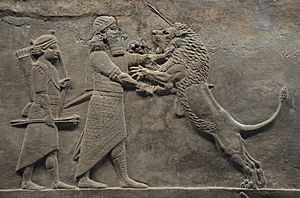
After Esarhaddon died, his son Ashurbanipal became king of Assyria. His other son, Shamash-shum-ukin, became king of Babylon. Ashurbanipal held a grand celebration for his brother in Babylon. Even though Shamash-shum-ukin was king, he was still under Ashurbanipal's rule. Assyrian governors and soldiers remained in the south.
Ashurbanipal continued his father's work. In 667 BC, he finished the campaign against Egypt. He marched all the way to Thebes, taking riches along the way. He left Psamtik I and Necho I as vassal rulers. In 666–665 BC, Ashurbanipal stopped Tantamani, Pharaoh Taharqa's nephew, from retaking Egypt.
As Shamash-shum-ukin grew stronger, he wanted to be independent. In 652 BC, he joined with Assyria's enemies. These included Elam, Kush, and the Chaldeans. He also stopped Ashurbanipal from making sacrifices in southern cities. This led to a four-year civil war. By 650 BC, Shamash-shum-ukin was losing. Ashurbanipal's forces surrounded Babylon. Babylon finally fell in 648 BC and was looted. Shamash-shum-ukin died.
Ashurbanipal ruled for a long time. He fought against all of Assyria's enemies. After Ashurbanipal's death, his sons ruled for a while. But many of Assyria's vassals broke away. From 627 to 612 BC, the Assyrian Empire slowly fell apart. A group of enemies, mainly the Median Empire and the new Neo-Babylonian Empire, attacked Assyria. In 612 BC, Nineveh was looted and destroyed. Assyria finally fell in 609 BC.
What Historians Say
Esarhaddon, his father Sennacherib, and his son Ashurbanipal are seen as three of the greatest Assyrian kings. Esarhaddon is often described as gentler than his father. He tried harder to make conquered people feel like part of the empire. He is considered one of the most successful Assyrian rulers. His achievements include conquering Egypt, peacefully controlling Babylonia, and his huge building projects.
Historian Karen Radner says that Esarhaddon is known more as a person than other Assyrian kings. This is because many documents from his rule, like court letters, have survived. Most kings are only known from their official writings.
Ashurbanipal, who later created a famous library, started collecting ancient writings during Esarhaddon's reign. It's possible that Esarhaddon encouraged Ashurbanipal's love for learning and collecting books.
Titles
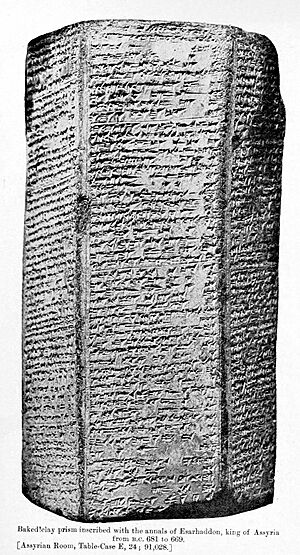
In his writings, Esarhaddon used many grand titles. Here are some examples:
Esarhaddon, the great king, king of Assyria, ruler of Babylon, king of Sumer and Akkad, king of the four regions of the earth, loved by the great gods, his lords. The gods chose his name for kingship.
Another inscription shows more of his titles:
Esarhaddon, the great king, the mighty king, king of the Universe, king of Assyria, ruler of Babylon, king of Sumer and Akkad. Son of Sennacherib, the great king, king of Assyria. Grandson of Sargon, the great king, king of Assyria. With the help of the great gods, his lords, he traveled from the rising to the setting sun, having no rival.
A longer list of his titles and boasts about his gifts from the gods reads:
I am Esarhaddon, king of the Universe, king of Assyria, mighty warrior, first among all princes. Son of Sennacherib, king of Assyria. Grandson of Sargon, king of the universe, king of Assyria. The gods called me to kingship to restore their images and rebuild all cities. I built the temple of Assur. I restored Esagila and Babylon. I returned the gods' statues to their places. I made them live there peacefully forever. I marched with their power, from east to west, having no rival. I made the princes of the four corners of the world surrender to me. The gods sent me against every land that rebelled against Assyria. Assur, father of the gods, told me to make people live in peace and expand Assyria's borders. Sin, lord of the crown, gave me power and bravery. Shamash, light of the gods, gave me great fame. Marduk, king of the gods, made the fear of my rule spread like a storm. Nergal, the mighty god, gave me fear, terror, and awesome glory. Ishtar, queen of battle, gave me a mighty bow and javelin.
See also
- Esarhaddon's Treaty with Ba'al of Tyre
- Esarhaddon's Succession Treaty
- List of Assyrian kings
- Military history of the Neo-Assyrian Empire
Images for kids
-
Another clay record of Esarhaddon's restoration of Babylon. Exhibited at the Metropolitan Museum of Art.
-
Relief from the Temple of Amun, Jebel Barkal, showing Kushites defeating Assyrians



